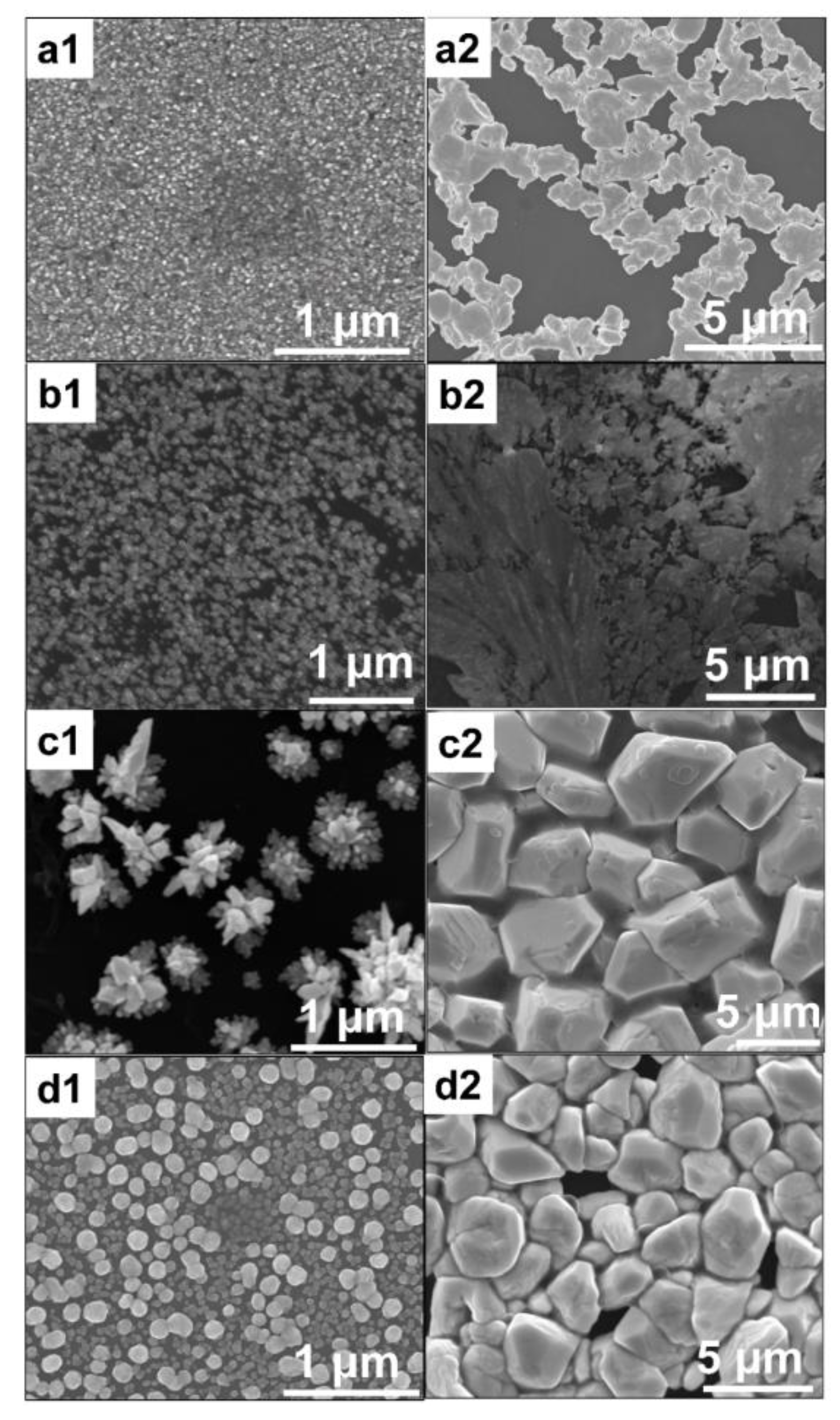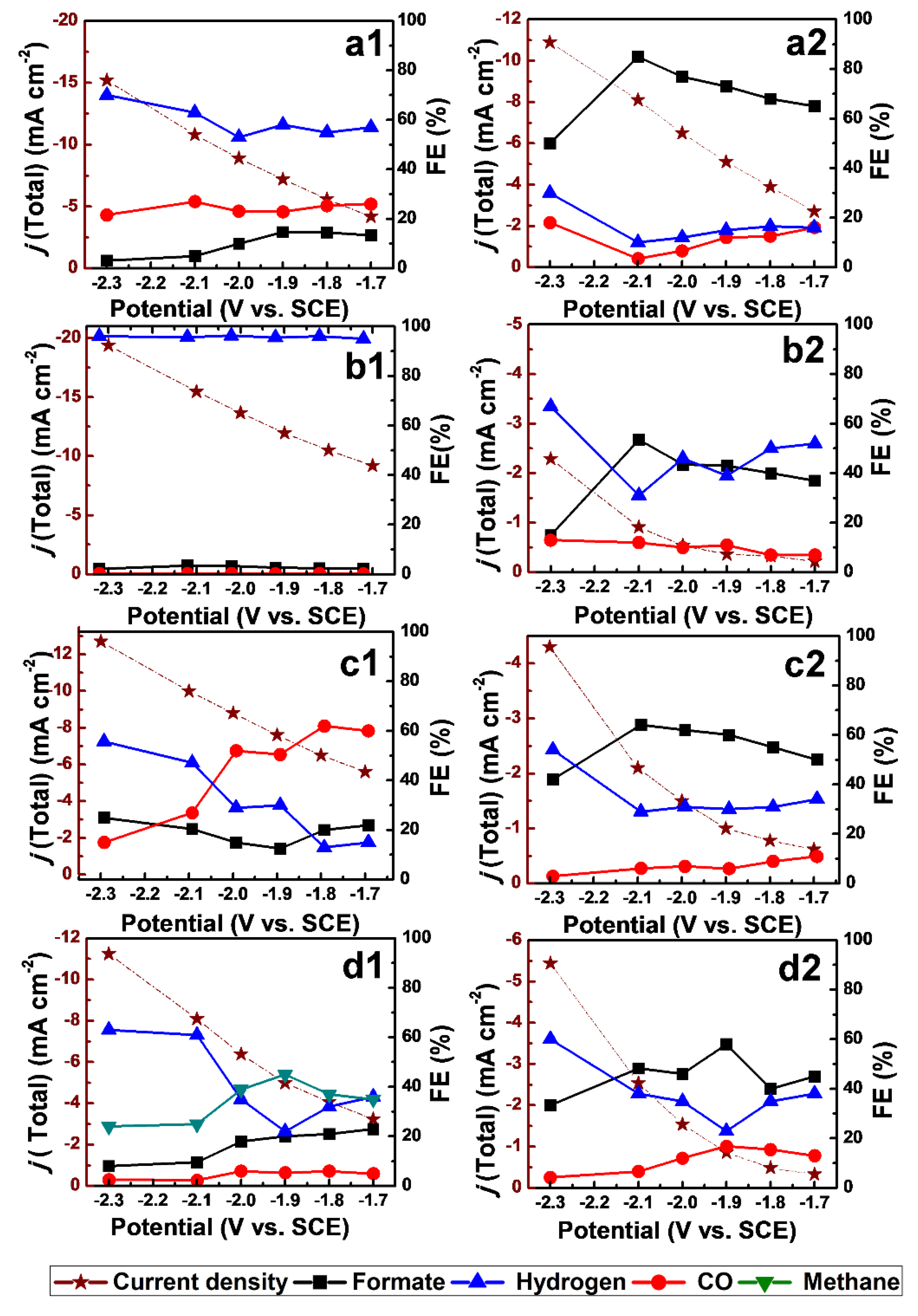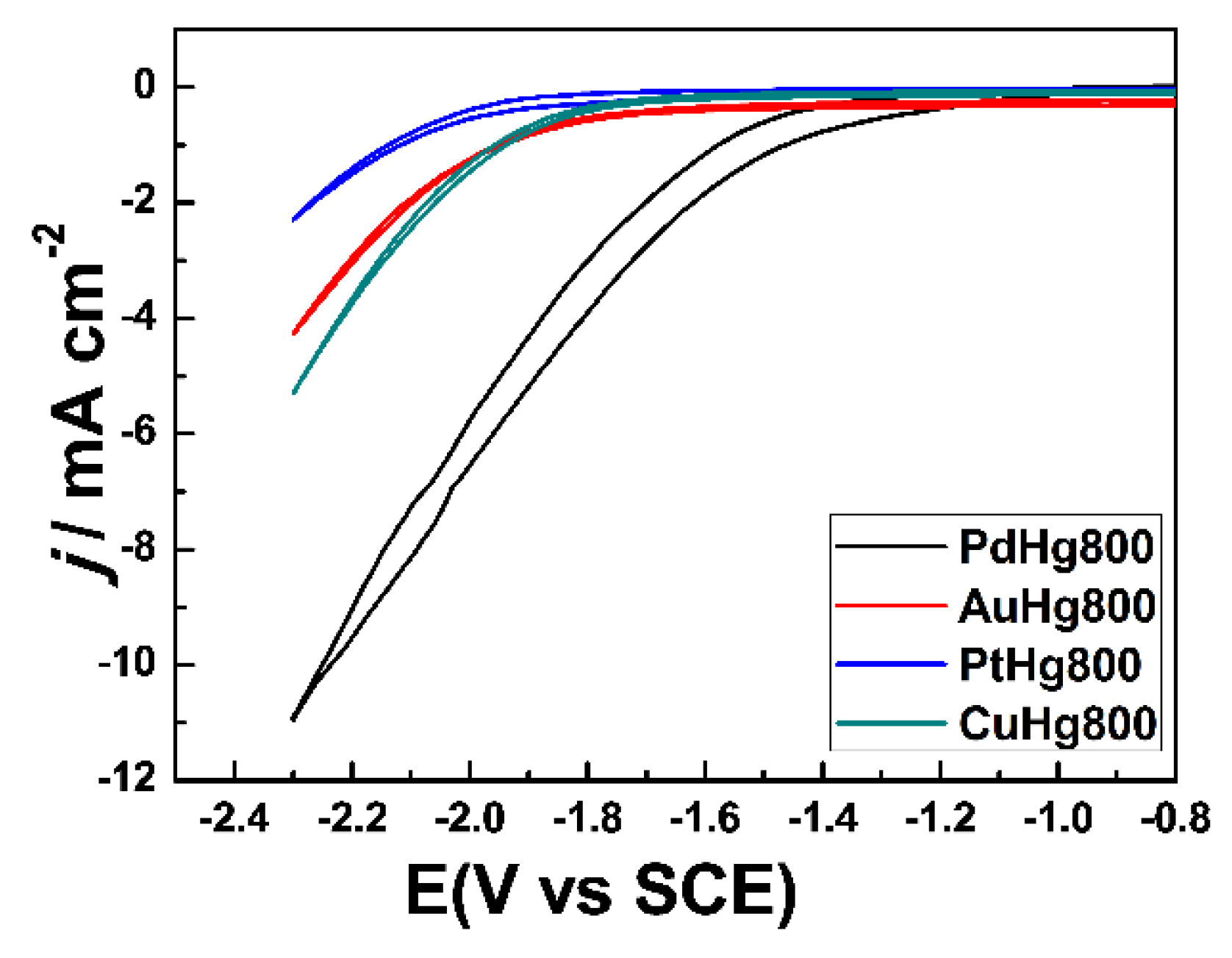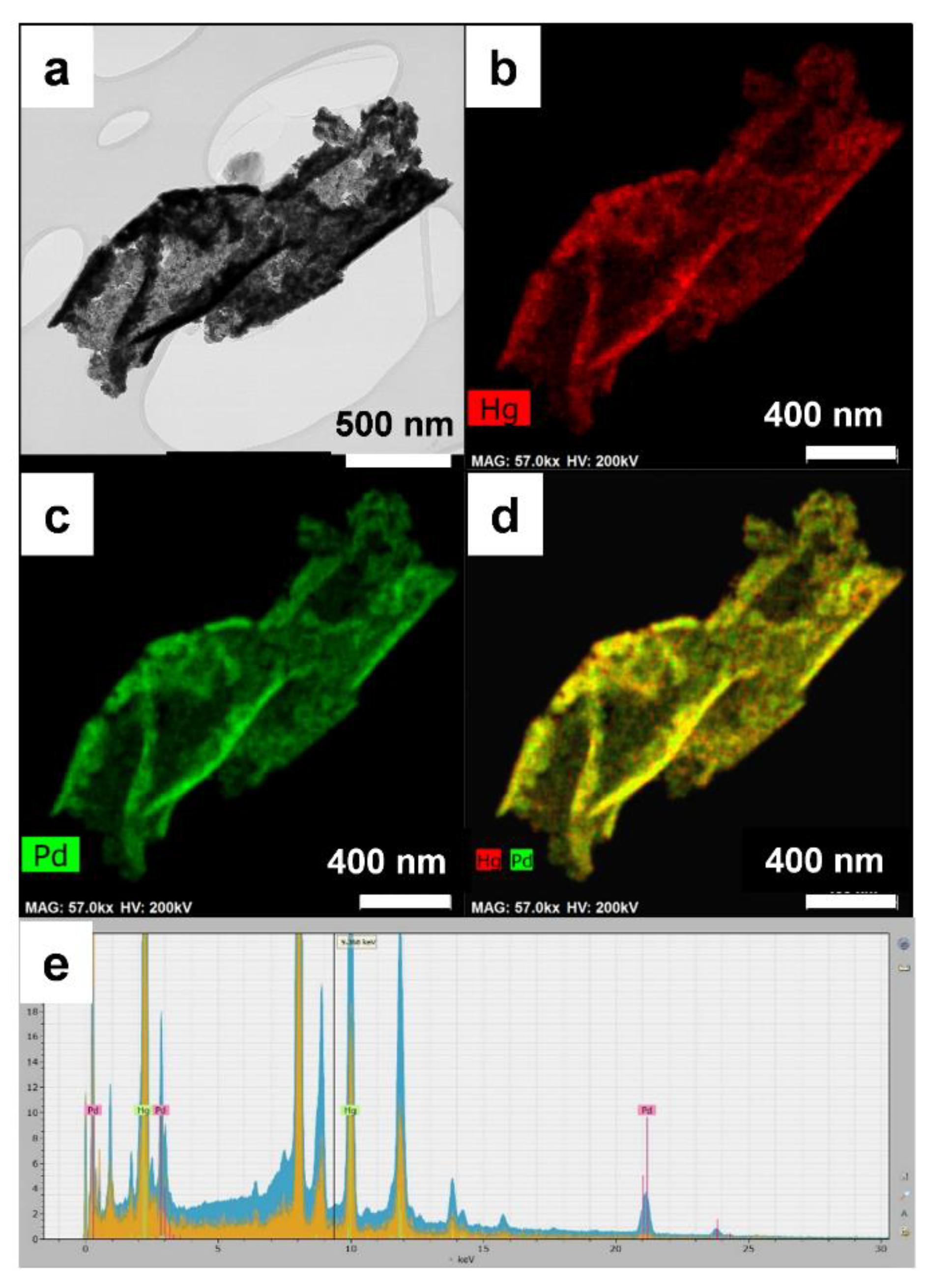Preparation of Metal Amalgam Electrodes and Their Selective Electrocatalytic CO2 Reduction for Formate Production
Abstract
:1. Introduction
2. Results and Discussion
3. Materials and Methods
3.1. Materials
3.2. Synthesis of Electrode
3.3. Material Characterization and Product Analysis
3.4. Electrochemical Characterization
4. Conclusions
Supplementary Materials
Author Contributions
Funding
Conflicts of Interest
References
- U.S. Energy Information Administration (EIA). Annual Energy Outlook 2015 (AEO2015), with Projections to 2040. April 2015; DOE/EIA-0383(2015); pp. 1–154. Available online: http://www.eia.gov/outlooks/aeo/pdf/0383(2015).pdf (accessed on 7 December 2018).
- Tan, X.; Tahini, H.A.; Smith, S.C. Computational design of two-dimensional nanomaterials for charge modulated CO2/H2 capture and/or storage. Energy Storage Mater. 2017, 8, 169–183. [Google Scholar] [CrossRef]
- Ozin, G.A. Throwing New Light on the Reduction of CO2. Adv. Mater. 2015, 27, 1957–1963. [Google Scholar] [CrossRef]
- Du, D.; Lan, R.; Humphreys, J.; Tao, S. Progress in inorganic cathode catalysts for electrochemical conversion of carbon dioxide into formate or formic acid. J. Appl. Electrochem. 2017, 47, 661–678. [Google Scholar] [CrossRef]
- Agarwal, A.S.; Zhai, Y.; Hill, D.; Sridhar, N. The electrochemical reduction of carbon dioxide to formate/formic acid: Engineering and economic feasibility. ChemSusChem 2011, 4, 1301–1310. [Google Scholar] [CrossRef] [PubMed]
- Qiao, J.; Liu, Y.; Hong, F.; Zhang, J. A review of catalysts for the electroreduction of carbon dioxide to produce low-carbon fuels. Chem. Soc. Rev. 2014, 43, 631–675. [Google Scholar] [CrossRef]
- Boddien, A.; Gärtner, F.; Federsel, C.; Sponholz, P.; Mellmann, D.; Jackstell, R.; Junge, H.; Beller, M. CO2-“Neutral” hydrogen storage based on bicarbonates and formates. Angew. Chem. Int. Ed. 2011, 50, 6411–6414. [Google Scholar] [CrossRef]
- Kortlever, R.; Balemans, C.; Kwon, Y.; Koper, M.T.M. Electrochemical CO2 reduction to formic acid on a Pd-based formic acid oxidation catalyst. Catal. Today 2015, 244, 58–62. [Google Scholar] [CrossRef]
- Jones, J.P.; Prakash, G.K.S.; Olah, G.A. Electrochemical CO2 Reduction: Recent Advances and Current Trends. Isr. J. Chem. 2014, 54, 1451–1466. [Google Scholar] [CrossRef]
- Liu, M.; Pang, Y.; Zhang, B.; De Luna, P.; Voznyy, O.; Xu, J.; Zheng, X.; Dinh, C.T.; Fan, F.; Cao, C.; et al. Enhanced electrocatalytic CO2 reduction via field-induced reagent concentration. Nature 2016, 537, 382–386. [Google Scholar] [CrossRef]
- Koh, J.H.; Won, D.H.; Eom, T.; Kim, N.K.; Jung, K.D.; Kim, H.; Hwang, Y.J.; Min, B.K. Facile CO2 Electro-Reduction to Formate via Oxygen Bidentate Intermediate Stabilized by High-Index Planes of Bi Dendrite Catalyst. ACS Catal. 2017, 7, 5071–5077. [Google Scholar] [CrossRef]
- Paik, W.; Andjbsen, T.N.; Eyring, H. Kinetic studies of the electrolytic reduction of carbon dioxide on the mercury electrode. Electrochim. Acta 1969, 14, 1217–1232. [Google Scholar] [CrossRef]
- Yoshio, H.; Shin, S. Electrolytic Reduction of Carbon Dioxide at Mercury Electrode in Aqueous Solution. Bull. Chem. Soc. Jpn. 1982, 55, 660–665. [Google Scholar] [CrossRef]
- Surmann, P.; Zeyat, H. Voltammetric analysis using a self-renewable non-mercury electrode. Anal. Bioanal. Chem. 2005, 383, 1009–1013. [Google Scholar] [CrossRef] [PubMed]
- Mikkelsen, Ø.; Schrøder, K.H. Amalgam electrodes for electroanalysis. Electroanalysis 2003, 15, 679–687. [Google Scholar] [CrossRef]
- Yosypchuk, B.; Barek, J. Analytical Applications of Solid and Paste Amalgam Electrodes. Crit. Rev. Anal. Chem. 2009, 39, 189–203. [Google Scholar] [CrossRef]
- Valera, D.; Espinoza-Montero, P.J.; Alvarado, J.; Carrera, P.; Bonilla, P.; Cumbal, L.; Fernándeza, L. Development and evaluation of a glassy carbon electrode modified with silver and mercury nanoparticles for quantification of cysteine rich peptides. Sens. Actuators B Chem. 2017, 253, 1170–1179. [Google Scholar] [CrossRef]
- Martins, M.E.; Salvarezza, R.C.; Arvia, A.J. The electrodeposition of mercury from aqueous Hg22+ ion-containing acid solutions on smooth and columnar-structured platinum electrodes. Electrochim. Acta 1997, 43, 549–561. [Google Scholar] [CrossRef]
- Antwi, C.; Johnson, A.S.; Selimovic, A.; Martin, R.S. Use of microchip electrophoresis and a palladium/mercury amalgam electrode for the separation and detection of thiols. Anal. Methods 2011, 3, 1072–1078. [Google Scholar] [CrossRef]
- Todoroki, M.; Hara, K.; Kudo, A.; Sakata, T. Electrochemical reduction of high pressure CO2 at Pb, Hg and In electrodes in an aqueous KHCO3 solution. J. Electroanal. Chem. 1995, 394, 199–203. [Google Scholar] [CrossRef]
- Economou, A.; Fielden, P.R. Mercury film electrodes: Developments, trends and potentialities for electroanalysis. Analyst 2003, 2, 814–815. [Google Scholar] [CrossRef]
- Yosypchuk, B.; Fojta, M.; Barek, J. Preparation and properties of mercury film electrodes on solid amalgam surface. Electroanalysis 2010, 22, 1967–1973. [Google Scholar] [CrossRef]
- Zhang, W.; Hu, Y.; Ma, L.; Zhu, G.; Wang, Y.; Xue, X.; Chen, R.; Yang, S.; Jin, Z. Progress and Perspective of Electrocatalytic CO2 Reduction for Renewable Carbonaceous Fuels and Chemicals. Adv. Sci. 2018, 5. [Google Scholar] [CrossRef] [PubMed]
- Gao, D.; Zhou, H.; Wang, J.; Miao, S.; Yang, F.; Wang, G.; Wang, J.; Bao, X. Size-Dependent Electrocatalytic Reduction of CO2 over Pd Nanoparticles. J. Am. Chem. Soc. 2015, 137, 4288–4291. [Google Scholar] [CrossRef] [PubMed]
- Kauffman, D.R.; Alfonso, D.; Matranga, C.; Qian, H.; Jin, R. Experimental and computational investigation of Au25 clusters and CO2: A unique interaction and enhanced electrocatalytic activity. J. Am. Chem. Soc. 2012, 134, 10237–10243. [Google Scholar] [CrossRef]
- Li, Y.; Sun, Q. Recent Advances in Breaking Scaling Relations for Effective Electrochemical Conversion of CO2. Adv. Energy Mater. 2016, 6, 1–19. [Google Scholar] [CrossRef]
- Abbas, S.A.; Kim, S.-H.; Iqbal, M.I.; Muhammad, S.; Yoon, W.-S.; Jung, K.-D. Synergistic effect of nano-Pt and Ni spine for HER in alkaline solution: Hydrogen spillover from nano-Pt to Ni spine. Sci. Rep. 2018, 8, 2986. [Google Scholar] [CrossRef] [PubMed]
- Abbas, S.A.; Iqbal, M.I.; Kim, S.H.; Jung, K.D. Catalytic Activity of Urchin-like Ni nanoparticles Prepared by Solvothermal Method for Hydrogen Evolution Reaction in Alkaline Solution. Electrochim. Acta 2017, 227, 382–390. [Google Scholar] [CrossRef]
- Manthiram, K.; Beberwyck, B.J.; Alivisatos, A.P. Enhanced electrochemical methanation of carbon dioxide with a dispersible nanoscale copper catalyst. J. Am. Chem. Soc. 2014, 136, 13319–13325. [Google Scholar] [CrossRef] [PubMed]
- Lee, H.E.; Yang, K.D.; Yoon, S.M.; Ahn, H.Y.; Lee, Y.Y.; Chang, H.; Jeong, D.H.; Lee, Y.; Kim, M.Y.; Nam, K.T. Concave Rhombic Dodecahedral Au Nanocatalyst with Multiple High-Index Facets for CO2 Reduction. ACS Nano 2015, 9, 8384–8393. [Google Scholar] [CrossRef]
- Min, X.; Kanan, M.W. Pd-Catalyzed Electrohydrogenation of Carbon Dioxide to Formate: High Mass Activity at Low Overpotential and Identification of the Deactivation Pathway. J. Am. Chem. Soc. 2015, 137, 4701–4708. [Google Scholar] [CrossRef] [PubMed]
- Hori, Y. Electrochemical CO2 Reduction on Metal Electrodes. In Modern Aspects of Electrochemistry; Vayenas, C.G., White, R.E., Gamboa-Aldeco, M.E., Eds.; Springer: New York, NY, USA, 2008; pp. 89–189. [Google Scholar]
- Azuma, M.; Hashimoto, K.; Hiramoto, M.; Watanabe, M.; Sakata, T. Electrochemical Reduction of Carbon Dioxide on Various Metal Electrodes in Low-Temperature Aqueous KHCO3 Media. J. Electrochem. Soc. 1990, 137, 1772–1778. [Google Scholar] [CrossRef]
- Bukhtiyarov, A.V.; Prosvirin, I.P.; Saraev, A.A.; Klyushin, A.Y.; Knop-Gericke, A.; Bukhtiyarov, V.I. In situ formation of the active sites in Pd-Au bimetallic nanocatalysts for CO oxidation: NAP (near ambient pressure) XPS and MS study. Faraday Discuss. 2018, 208, 255–268. [Google Scholar] [CrossRef] [PubMed]
- Zangeneh Kamali, K.; Pandikumar, A.; Jayabal, S.; Ramaraj, R.; Lim, H.N.; Ong, B.H.; Bien, C.S.D.; Kee, Y.Y.; Huang, N.M. Amalgamation based optical and colorimetric sensing of mercury(II) ions with silver@graphene oxide nanocomposite materials. Microchim. Acta 2016, 183, 369–377. [Google Scholar] [CrossRef]








| Sample | Metal | Metal Deposition Time (s) | Hg Deposition Time (s) | XRD Phase |
|---|---|---|---|---|
| PtHg800 | Pt | 100 | 800 | PtHg4 (JCPDS-040045447) |
| AuHg800 | Au | 100 | 800 | Au0.82Hg0.18 (JCPDS-040035629) |
| CuHg800 | Cu | 100 | 800 | CuHg (JCPDS-040812) |
| PdHg800 | Pd | 100 | 800 | Pd2Hg5 (JCPDS-040046963) |
| PdHg200 | Pd | 100 | 200 | Pd/Pd2Hg5 (JCPDS-870639/040046963) |
| PdHg100 | Pd | 100 | 100 | Pd/Pd2Hg5 (JCPDS-870639/040046963) |
| Sample | Atomic Ratio (Pd/Hg) | Pd0 (3d5/2) eV | Pd0 (3d3/2) eV | Hg0 (4f7/2) eV | Hg2+ (4f7/2) eV | Hg0 (4f5/2) eV | Hg2+ (4f5/2) eV |
|---|---|---|---|---|---|---|---|
| PdHg800 | 2.48 | 335.7 | 341.0 | 100.2 | - | 104.3 | - |
| PdHg200 | 1.28 | 335.9 | 341.2 | 100.3 | 101.2 | 104.3 | 105.2 |
| PdHg100 | 0.15 | 335.8 | 341.1 | 100.2 | 101.2 | 104.2 | 105.3 |
© 2019 by the authors. Licensee MDPI, Basel, Switzerland. This article is an open access article distributed under the terms and conditions of the Creative Commons Attribution (CC BY) license (http://creativecommons.org/licenses/by/4.0/).
Share and Cite
Abbas, S.A.; Kim, S.-H.; Saleem, H.; Ahn, S.-H.; Jung, K.-D. Preparation of Metal Amalgam Electrodes and Their Selective Electrocatalytic CO2 Reduction for Formate Production. Catalysts 2019, 9, 367. https://doi.org/10.3390/catal9040367
Abbas SA, Kim S-H, Saleem H, Ahn S-H, Jung K-D. Preparation of Metal Amalgam Electrodes and Their Selective Electrocatalytic CO2 Reduction for Formate Production. Catalysts. 2019; 9(4):367. https://doi.org/10.3390/catal9040367
Chicago/Turabian StyleAbbas, Syed Asad, Seong-Hoon Kim, Hamza Saleem, Sung-Hee Ahn, and Kwang-Deog Jung. 2019. "Preparation of Metal Amalgam Electrodes and Their Selective Electrocatalytic CO2 Reduction for Formate Production" Catalysts 9, no. 4: 367. https://doi.org/10.3390/catal9040367
APA StyleAbbas, S. A., Kim, S.-H., Saleem, H., Ahn, S.-H., & Jung, K.-D. (2019). Preparation of Metal Amalgam Electrodes and Their Selective Electrocatalytic CO2 Reduction for Formate Production. Catalysts, 9(4), 367. https://doi.org/10.3390/catal9040367






